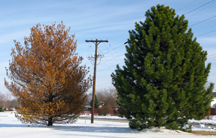

March 20, 2008
Weather stress turns evergreens to forever brown
WEST LAFAYETTE, Ind. - |
"After last summer's drought, most plants were under varying degrees of stress, and our winter weather did not help," said Janna Beckerman, a Purdue University assistant professor of botany and plant pathology. "However, the damage is not apparent until the temperatures warm up and the plant turns brown."
Winter burn is a result of plant dehydration. When a plant makes food through photosynthesis, it releases large amounts of water that the plant needs to replace. When plants are unable to get the water they need - either because of drought or frozen soil - they start to turn brown and shed needles. As the weather warms, the process speeds up.
"Winter burn is unsightly, but rarely fatal," said Gail Ruhl, a Purdue senior plant disease diagnostician. "Unfortunately there is not much we can do to reverse this process once it has begun. There is no chemical cure."
If a few branches are brown with no green buds, then those limbs should be removed. If an entire tree, including all the buds, is brown, it should be cut down quickly before bark beetles and borers infest it and spread to nearby species, Ruhl said.
Flooding produces similar symptoms to drought in many plants, including conifers, Beckerman said. She said plant roots drown during floods or prolonged wet periods and these dying roots are susceptible to root rot disease.
A little winter damage is normal, and most plants can survive it. But persistent damage weakens evergreens, predisposing them to insect pests and disease. Beckerman said adequate water, fertilizer and mulch can improve plant vigor and minimize the impact of such damage.
Writer: Beth Forbes, (765) 494-2722, forbes@purdue.edu
Sources: Janna L. Beckerman, (765) 494-4628, beckerm@purdue.edu
Gail Ruhl, (765) 494-4641, ruhlg@purdue.edu
Ag Communications: (765) 494-2722;
Beth Forbes, forbes@purdue.edu
Agriculture News Page
PHOTO CAPTION:
Winter burn, a condition caused when evergreens lack water, may be more prevalent this spring due to winter conditions and last summer's drought. Contrary to its name, winter burn damage starts to become apparent in spring when temperatures warm and plants seek to make food. (Purdue Agriculture photo/Janna Beckerman)
A publication-quality photo is available at https://www.purdue.edu/uns/images/+2008/beckerman-brown.jpg
To the News Service home page
If you have trouble accessing this page because of a disability, please contact Purdue News Service at purduenews@purdue.edu.
